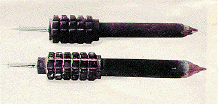Small Appliances
Fehta Murghana
According to Webster's Second Unabridged Dictionary, appliance means: the act of applying; application; as, the appliance of a theory; also: pliability; compliance; subservience; and lastly, and the one we are most familiar with: something applied to a particular use; a device or machine, especially for household us, an apparatus or instrument; as a mechanical appliance. The synonyms for appliance reflect this technique of applicability: contrivance. apparatus, device, machine, instrument, tool. Of course, 'applicable' itself, as a related term, means to join of fasten to.
Daily life is now a function of these 'joinings' or 'fastenings to' in the form of these small machines. These 'appliances' do, in fact, apply a theory; or rather, they are nodes wherein constellations of larger apparatuses (the state, economics, science), wheels within wheels, form their smaller cousins, devices. A washer and dryer combo is a manifestation of systematicity, a knot in the fabric of technique. We might even say that 'contraptions' form the demotic counterparts of appliances (which perhaps forms a sliding scale to a new daemonic, after the greek and not the christian)

The phenomenological appearing of a device is deceptive. The physical manifestation of a device is the last thing to 'appear'. A pure whorling in worlding spaces is there first.
The second thing we think of when the word 'appliance' is mentioned is domesticity. (Somewhat oxymoronic at this point in technological history, since a point could be made that appliances--at this point, cars, telephony, computers-- seem to pertain more to the archaic part of the above theory, that is, appliances seem to be applying slow (!) and steady pressure to the tradtional household. But for a previous generation--and perhaps large parts of the present one--the major domo of applicability (both technically and the 'joining to' of relaltionships) of household technology was the woman.

the sixty cycle hum of almost all appliances (and almost always subliminal): the spin cycle of the industrial system.
re-calls of appliances may extend farther than we thought if we consider the possiblity of memeory and trauma in regard to 'applicability' ( and what is being applied is the 'industrial system,' not a simple -- or recent -- thing.)

the idea of 'mediate catastrophe', apocalyptic only in the sense of a slow accretion of terror/violence--with no overt ideology attached (other than the systematicity required to maintain its production, which is a production of force), the only 'unveiling' that of application of force, in larger or smaller increments--the 'small catastrophe', every 'appliance' (what is that strictly?) an application of technique, a point de capiton, a mini-apocalypse, transmutation of energy/mass 'applied' to a specific, mundane situation; the catastrophe becomes normalized, naturalized. 'that's just the way it is', 'we need it to survive,' 'what else can we do?' each appliance a hole punched in a universe fabric, a black hole, transportable.
The appliance has a 'state of emergency' built into it, its failure mode (default position, redundancy) necessary for its operation.

Every manu-factured object is an explosive device that has already been exploded--and is now schrapnel in mid-flight. The hand is always a trigger.
A technological culture is always in a state of seige, under attack from within, a proximity that is inescapable inasmuch as it is nowhere and everywhere. Where is techne? where is ‘ability’? It stands ready constantly but where does it sit? It sits at the border always, facing outward with genitals bared, like the baboons guarding the troop, like the stone piles of Hermes, guarding the perimeter of the city. It (techne) sits as a shaped explosive charge, a landmine and a mindmine.
COLLECTIVE SYNCHRONIZATION CAN ACT LIKE A
PHASE TRANSITION.Several systems with large populations exhibit a coordinated ensemble behavior. For example, fireflies can flash in unison, crickets can chirp together, and pacemaker cells in the heart work together. Theorists, such as Yoshiki Kuramoto of the University of Kyoto (Japan), have supposed for some time that the onset of synchronization would be equivalent to a phase transition, like the transformation of water into ice, and have worked out formulas to deal with the problem. (Science News, 13 April 1996.) Now, physicists at Georgia Tech and Cornell have performed experimental studies of large series arrays of nonidentical Josephson junctions which bear out the models. As the input current was varied, the array showed two phase transitions, one in which the voltage oscillations of the junctions became partially synchronized, and a second in which the frequency coupling became complete. Normally, the junctions, which are all slightly different, would oscillate at their own natural frequencies. The researchers plan next to test two-dimensional arrays. (Kurt Wiesenfeld et al., Physical Review Letters, 15 January 1996.)
A somewhat paradoxical formulation on the front of some landmines:
"KEEP FRONT TOWARD ENEMY". Paradoxical formulation because once the mine is placed, everyone in front of it BECOMES the enemy. Landmines reside in immanentized spaces unlike sublime bombs bursting in air (even of enough affective import to creat nationialistic hymns out of it. But what nationalized border defense could be conceived along the lines of a landmine. Landmines confuse borders irretrievably (admittedly merely the next step in the global logistics of capitalized border collapse of a general kind which has yet very specific and horrific consequences); they are small, readily hidden and disguised; their distribution, in order to be effective, has to be sufficiently stochastic across time AND space (long after borders are re-established, the landmine is a time bomb, waiting to re-terror-torialize); in league with a brutal cybercapitalism, the landmine almost acts as a catalyst for prosthetic development, since extremeties are most often lost in contact with landmines.
And of course there are now 'smart' landmines containing computer chips. In the movie 'Screamers' (adapted from a Philip K. Dick short story), landmines begin to evolve their own evolutionary strategy, drawn by their own peculiar telos of ‘destruction of the other’. As in biological evolution quite often, that strategy is one of mimesis and meme transfer. In this case the mines become ambulatory, taking advantage of human affective responses by mimicing children first, then women, and finally wounded soldiers.
The result is a desolate and abject landscape, with uncertainty and paranoia being the constitutive states. The possibility is that everything that appears to be a subjectivity may in fact be hollowed out and replaced with an explosive and/or prosthetic device. (And is similar to 'Bladerunner' wherein false memories are implanted and a range of uncertainties begin to set in as to the nature of memory and identity; the scenarios in both movies enact an increasing erasure of the line between the artificial and the natural, the living and the dead. In yet another recent movie, The Eraser, Arnold Schwartznegger plays a federal agent who must pretect informants by giving them new identities. The oneline for the films advertise ment goes: : "He must destroy their past to protect their future". In post modern time, the messianic eruption of a nowtime that would be utopian in its import, has now become the eruption of a deadtime. projected from the future, killing the past, by imitating the present, all under the aegis of a new global technological order)
Landmines, and their software components or viruses, are the tropes (and hence realities) which now govern the age: memory, tauma, terror, boundary confusions of all kinds. The 'contemporary adventures of subjectivity' are quite often the result of explosions of implanted autonomously reproducible control structures of increasingly infinite density and hence minaturaization (perhaps, ultimately, the death meme, a reversible codicil on our biological codons); but for now they function as cultural blockages installed by a civilization intent on Control, Communication, and Command, from the inside out, psyche to physics.: defoliation of the Garden of Eden then installation of. . . installations and projects. We have become children of Judge Schreber: hollowed out, with replaceable innards and chiasmatic sexualities, and bombarded by control rays from some mysterious foreign object(s) which can as yet only barely be perceived (perhaps it is even ourselves, beckoning from the future). We are perhaps reaching a time when the historical attractor for the human species will be the 'futural ones' as Martin Heidegger put it, and not the archival past; passage to the rear is already heavily mined and the sorties continue . . . even as we speak.

One of the most readily (un)observable features of small applicances of all sorts is their finitude, in correspondence then to our complacency, and hence their banality, even though encapsulating the most ferocious energies. This 'clarity' of purpose that the banal gives conceals however, like all gifts, a fundamental misprision, a collapse or catastrophe constrained by (and hence facilitating) the not-yet-system which strains, in its fragmentary state, to coalesce into an 'installation' (gestell) which yet 'frags' again. This dehiscent encompassing, spore-like yet mechanical, a crash rather than prologomena to fertilization, completes a modernist deliquiscence of all possibilities into a lurid Ballardian (J. G.) landscape of crashes, craters, jagged heaps, stumps, lunps, leaks, ghosts, and stains.
Each appliance is a point guard for a team which is everywhere and nowhere, a system of collapse the instauration of which is complete before the arrival of the first widget . . . the widget being always only the arrival of the first fragment. It is a causality running in the opposite direction of time's arrow from the world of biology, forming a moving crosshairs of 'manifestation', coming from ahead, picking up speed, and moving yet further ahead. It's no wonder no one can keep up; the orthogonal nature of such a system becomes increasingly oblique to human concerns. In the 'system' of 'techne' all human endeavors become 'projects' (and eventually, 'installations', set off from, demarcated by an endless series of scare quotes, turning all aspects of life into paraphrastic inscription. Even so, god is no longer grammar, pace Nietzsche, but the little toaster who could.

"I submit that we will have to abandon the border-based concept
of 'Fortress America' and recognise that our national interests
may be endangered from within."
John Alexander, guru of non-lethal weapons research
The fractal-like 'enfolded infinity' of appliance is the progressive emplacement of Hegel's 'bad infinity' into the heart of the human community, a donation from the mathematical sublime (and in that it is part of the fractalization represented by the "inoperative community". Of course. That's the reason it's the 'bad' infinite, the mathematical usurping and limiting the phenomenological Thought of the boundless true infinite. Which doubtless the human community represented [at least for Hegel, in its dialectical continuity]-- before the finitizing explosions of modernist landmines perhaps:
 "Such an infinite which is only a particular alongside the finite and which has its bound or limit therein is NOT what it ought to be, not the infinite, but only FINITE. In such a relationship, with the finite HERE and the infinite AWAY YONDER, the one immanent the other transcendental, the finite is invested with the same dignity of permanence and independence as the infinite." Hegel
"Such an infinite which is only a particular alongside the finite and which has its bound or limit therein is NOT what it ought to be, not the infinite, but only FINITE. In such a relationship, with the finite HERE and the infinite AWAY YONDER, the one immanent the other transcendental, the finite is invested with the same dignity of permanence and independence as the infinite." HegelAs in most supplements, the parasitic investment of the 'bad' [perhaps even one definition of the supplementary)]infinity [techne?] seems to be in the process of driving out the [presumably] 'good' infinity.)
 Cordyceps sinensis: It is formed by the parasitism of the fungus Codyceps sinensis on the larva of Hepialus virescens. The larva hibernates underground in winter and the spore of teh fungus enters the body of the
larva and feeds on it and causes its death. At the end of spring and the beginning summer of the next year, the spore of the fungus will
grow out of the head of lthe larva and come out of the ground like a little grass. That is why it got
its Chinese name 'Dongchong Xiacao' meaning winter larva, summer larva. Used as a tonic.
Cordyceps sinensis: It is formed by the parasitism of the fungus Codyceps sinensis on the larva of Hepialus virescens. The larva hibernates underground in winter and the spore of teh fungus enters the body of the
larva and feeds on it and causes its death. At the end of spring and the beginning summer of the next year, the spore of the fungus will
grow out of the head of lthe larva and come out of the ground like a little grass. That is why it got
its Chinese name 'Dongchong Xiacao' meaning winter larva, summer larva. Used as a tonic.